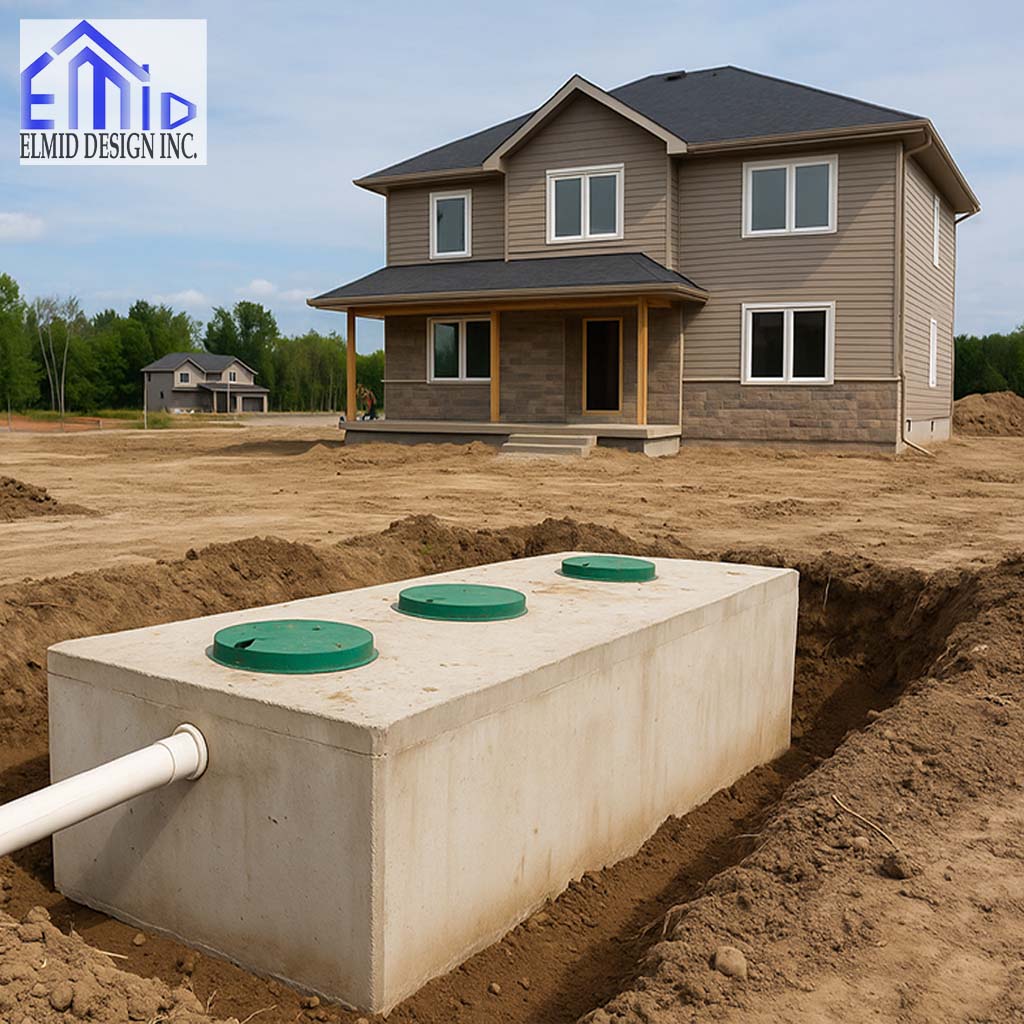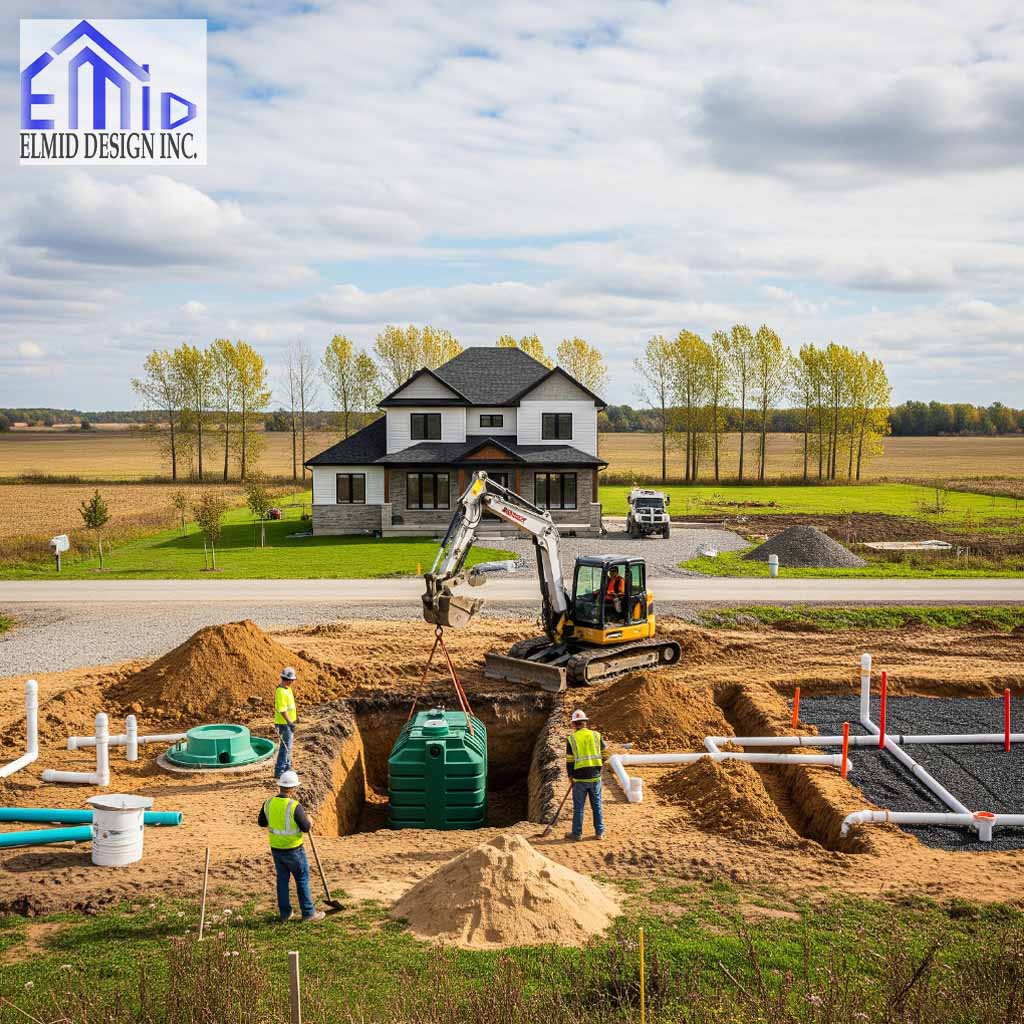This article explores septic design Georgina by clearly guiding property owners through Georgina’s approval and permit process. Moreover, it emphasizes trusted expertise while maintaining authoritative standards for both accuracy and clarity.
Understanding Septic Design in Georgina
Septic design in Georgina requires a precise site‑specific plan drawn to scale, often by licensed professionals such as a P.Eng. or a certified designer with a BCIN. The design must include site layout, soil evaluation, and system specifications to meet Ontario Building Code Part 8 standards and municipal regulations. Owners must submit the complete design as part of a permit application to the Town’s Building Division. They may also require approval from the Lake Simcoe Region Conservation Authority (LSRCA) if regulation applies.
Permit Requirements and Process
When seeking a septic system permit, property owners or their agents must submit a Permit to Construct or Demolish application along with Schedule 1 for designer credentials and Schedule 2 for installer information. Designers must demonstrate competency and must often hold a BCIN registration. A detailed site plan is essential and must match survey data, showing all buildings, lot lines, wells, watercourses, and the proposed system.
Role of Site Alteration and Conservation Permits
Septic system installations often need a Site Alteration and Entrance Permit (SAEP), particularly when grading or altering drainage. This permit applies to new systems or system modifications and ensures that changes do not affect neighboring properties. SAEP drawings must accompany the building permit submission and must be prepared by professionals. If the property lies within an area overseen by LSRCA, additional approval is required.
Inspection and Maintenance Protocols
Once installed, septic systems in Georgina fall under a mandatory maintenance inspection program. Systems must be inspected by municipal inspectors every five years from the date of construction or last maintenance. Inspection follows a phased audit approach. Property owners receive notification and may proactively request an inspection through the Building Division. The program supports public health and watershed protection, particularly Lake Simcoe.
Technical Components of a Septic System
A septic system includes a septic tank and a drain field. The tank holds wastewater and separates solids from liquids. Effluent then flows into a drain field where soil filtration completes treatment. Soil permeability must suit effluent absorption, requiring percolation testing. In challenging soil conditions, alternative systems like mound systems may be used to protect groundwater and ensure environmental safety.
Soil Testing and System Suitability
Designers must assess soil texture, structure, and permeability through a percolation test. This ensures that the soil treats wastewater properly and prevents contaminants from reaching groundwater or Lake Simcoe. In coarse soils, effluent may travel too fast. In clay or impermeable soils, drainage may fail. Designers may recommend mound systems or biofilters to improve treatment in such locations.
Hiring Qualified Designers and Installers
Hiring qualified professionals builds trust and ensures compliance. In Georgina, septic designers and installers must register with Ontario’s Ministry of Municipal Affairs and Housing and carry BCIN credentials. Professional engineering firms create designs that meet code, protect health, and minimize environmental risk. LSK Septic and Drain, Crawford Septic, and Brock Excavation are among local experts offering both design and installation services.
Environmental and Public Health Significance
A properly designed and maintained septic system protects groundwater, surface water, and public health. It avoids costly failures, pathogens, and nutrient pollution. Georgina’s regulatory framework, including mandatory inspections and permit oversight, reflects provincial and municipal commitments to safe wastewater management, especially as it relates to Lake Simcoe’s watershed.
Local Resources and Building Division Support
Property owners can access septic plans, surveys, or compliance letters through Georgina’s Building Division. These records help verify past installations or enable planning for replacements. For detailed guidance, the Building Division serves as a primary contact for permits, maintenance, and system requirements.

Common Design Mistakes to Avoid
Many septic system failures in Georgina result from poor initial design. Common mistakes include undersized tanks, improper setback distances, and neglecting seasonal groundwater levels. These oversights can lead to premature system failure or even legal issues. Designers must follow the Ontario Building Code precisely and account for soil saturation, proximity to wells, and system loading. Overlooking these requirements creates long-term risks for homeowners. Professionals like Elmid Design Inc., which holds a certificate of authorization from Professional Engineers Ontario (PEO), ensure that designs meet regulatory and environmental expectations.
The Importance of Licensed Engineering Support
Septic system design isn’t a generic process. Each site in Georgina presents unique challenges. A licensed professional like those at Elmid Design Inc. brings engineering insight that goes beyond standard layout. They apply geotechnical and hydrological understanding to match system design with the site’s realities. This leads to systems that function efficiently and stand up to inspections. Their certificate of authorization under PEO adds credibility and confirms technical accountability.
Costs Associated with Septic Design and Installation
Design and installation costs for septic systems in Georgina vary based on property layout, system complexity, and soil conditions. Standard designs may cost less, but unique or environmentally sensitive areas increase design and installation fees. Hiring an experienced professional can reduce overall cost by avoiding rework or failed inspections. Permit fees, soil tests, and inspections also factor into total expenses. While upfront costs seem high, the long-term reliability of a well-designed system offsets future repairs.
Choosing Between Conventional and Advanced Systems
Homeowners in Georgina often choose between conventional gravity-fed systems and more advanced options like tertiary treatment systems. Conventional systems work well on large lots with sandy soil and proper drainage. Advanced systems, including aerobic treatment units, serve sites with high water tables, small lots, or clay soil. These require electrical components and regular maintenance but provide enhanced treatment. Elmid Design Inc. often recommends system types based on performance, approval likelihood, and cost-effectiveness.
Winter Considerations for Septic Design
Designing a septic system in Georgina must include winter functionality. Freezing temperatures affect tank performance, piping, and drain field absorption. Design elements like insulation, trench depth, and effluent flow rate help systems operate reliably in sub-zero temperatures. Systems installed too shallow risk freezing, leading to system shutdown or damage. Designers should consider the frost line and avoid routing under driveways or compacted areas that hold snow and delay thawing in spring.
Legal and Environmental Compliance
Regulatory compliance is essential in Georgina due to environmental concerns near Lake Simcoe and surrounding watersheds. The Town and the LSRCA enforce rules to prevent groundwater pollution. Systems must maintain separation distances from water sources and natural features. Non-compliance leads to stop-work orders, fines, or forced removal. Engineers from PEO-authorized firms understand these rules and ensure designs meet all obligations. Environmental compliance also protects future property sales and supports clean water initiatives.
Importance of System Maintenance Plans
After installation, ongoing maintenance keeps systems efficient. Georgina’s five-year inspection program identifies issues before they escalate. Property owners must keep records of pump-outs, repairs, and system evaluations. Failing to maintain a system leads to early failure and environmental damage. Engineers often design with maintenance in mind by including easy access points, clear documentation, and long-lasting materials. Maintenance planning also reduces emergency repair costs and ensures smoother property transactions.
Key Questions to Ask Your Septic Designer
Homeowners should ask several important questions before hiring a septic designer. These include whether the designer has a BCIN or PEO license, what experience they have with Georgina’s terrain, and whether they include LSRCA coordination. Homeowners should also request sample designs and project timelines. Engineers at Elmid Design Inc. provide comprehensive consultations that address these concerns and prepare homeowners for each step, from design to approval and inspection.
Local Climate and Septic Performance
Georgina’s variable climate affects septic system operation. Heavy spring rains raise groundwater levels, which may flood drain fields. Drought in summer hardens soil, restricting effluent absorption. Designers must anticipate these seasonal cycles. This involves choosing appropriate system locations, reserving backup areas, and calculating flows accurately. Winter frost depth and snow accumulation also factor into long-term performance. A system designed for all seasons performs better and reduces repair risk.
Innovations in Septic System Technology
Advances in septic system technology provide Georgina property owners with better performance and environmental protection. Modern systems use aerobic treatment, UV disinfection, and advanced filtering to treat wastewater more efficiently. These systems work well in areas with limited space, poor soil, or nearby water sources. Engineers consider new technologies during the design phase and match them with site conditions. Homeowners benefit from reduced maintenance and fewer environmental risks. Elmid Design Inc. stays updated on system innovations to deliver effective and code-compliant solutions.
Integrating Septic Design with Site Grading
Proper site grading plays a major role in septic design success. Without correct slopes, water may pool near the system and disrupt drainage. During the design process, engineers analyze existing topography and develop grading plans that move surface water away from tanks and fields. They also use grading to protect nearby buildings and wells. In Georgina, where changing terrain and seasonal precipitation present challenges, grading becomes a critical step that supports long-term septic performance.
Septic System Failure and Warning Signs
Failure signs in septic systems include slow drains, unpleasant odors, soggy soil, or sewage backups. These issues often signal tank overflows or blocked leaching fields. Homeowners in Georgina must respond quickly to these signs to prevent property damage and health risks. Designs that don’t account for daily flow rates, soil load, or tank access often lead to premature failure. A proactive design by licensed engineers prevents many common issues. Early diagnosis also reduces repair costs and disruption.
Connecting with Local Health and Building Officials
Establishing a clear connection with local health and building officials ensures the smooth progression of septic projects. The Town of Georgina requires detailed submittals for permit approval and ongoing inspections. These authorities ensure that installations meet health and safety standards. Engineers often communicate directly with municipal staff to resolve technical concerns, provide clarifications, and submit revised documents. A well-documented project that meets all requirements avoids delays and supports full system approval.
Real Estate Considerations for Septic Systems
Septic systems impact real estate transactions in Georgina. Buyers often request records of design, permits, and inspections. A well-maintained system adds property value and provides peace of mind. Conversely, undocumented or failing systems raise red flags and may lead to renegotiated terms. Sellers should prepare by gathering all system records and ensuring up-to-date maintenance. Licensed designers can also conduct assessments to validate system integrity. This step builds buyer confidence and helps finalize sales without septic-related complications.
The Role of Engineers in Septic Problem Resolution
When septic systems fail or inspections raise concerns, engineers provide structured problem-solving and redesign support. They assess the existing system, identify causes of failure, and propose correction strategies that meet code. In Georgina, involving an engineer early in the resolution process speeds up approvals and avoids repeated inspection failures. Elmid Design Inc. specializes in troubleshooting and retrofitting existing septic systems to bring them into compliance while minimizing costs for property owners.
Septic System Longevity and Replacement Planning
A properly designed septic system lasts 20 to 30 years, depending on use and maintenance. Homeowners should plan for replacement by monitoring system age, keeping up with inspections, and saving for eventual upgrades. In Georgina, property development, lot severance, or zoning changes may also require system redesign. Professional firms like Elmid Design Inc. help homeowners understand system lifespan and create phased replacement plans. Timely planning reduces risk and ensures uninterrupted wastewater management.
Impact of Local Bylaws on Septic Design
Local bylaws in Georgina impose critical design restrictions that influence system layout and approval. These bylaws govern setbacks, system sizing, and location in relation to property boundaries and natural features. Municipal requirements also dictate submission standards for permits and inspection protocols. When homeowners ignore local regulations, they often face delays, redesign costs, or outright rejection of permit applications. By working with an engineering firm like Elmid Design Inc., designers can align plans with current bylaws and streamline the approval process without unexpected revisions.
Understanding the LSRCA Regulation Map
The Lake Simcoe Region Conservation Authority (LSRCA) regulates much of the land surrounding Georgina, especially near rivers, wetlands, and floodplains. Their mapping system outlines protected zones where special permits are needed. Before designing a septic system, engineers check whether a property falls under LSRCA jurisdiction. If it does, additional environmental impact assessments or alternative designs may be required. Early mapping review avoids regulatory conflicts and helps speed up approvals. Elmid Design Inc. incorporates LSRCA mapping into every design plan when applicable.
Septic Design Strategies for Clay Soils
Clay soils present one of the most difficult challenges for septic design in Georgina. Their low permeability prevents wastewater from dispersing naturally. Without intervention, clay-heavy sites lead to saturated drain fields, odor, and overflow issues. To address this, engineers may recommend raised bed systems, pressure distribution networks, or tertiary treatment systems. Each option provides enhanced treatment and better infiltration performance. Selecting the right solution depends on detailed soil testing and hydraulic analysis, which licensed professionals manage as part of the design.
Planning for Limited Lot Sizes
Many properties in Georgina, especially older or seasonal lots, offer limited space for septic infrastructure. Consequently, smaller lots restrict tank placement, reduce setback options, and frequently require creative solutions. Therefore, engineers must optimize every square meter of land while also meeting Ontario Building Code requirements. In these cases, compact treatment units or shallow buried trench systems may offer practical alternatives when space is tight. Furthermore, Elmid Design Inc. evaluates every dimension, considers grading constraints, and ultimately proposes designs that function within the site’s physical limits while still passing inspection.
Integrating Stormwater and Septic Design
Septic systems and stormwater management must work together, particularly on sloped lots or those near water bodies. Poor drainage planning leads to saturated fields and system failure. Designers assess runoff paths and create grading plans that divert stormwater away from septic components. Swales, berms, and elevation changes all contribute to better stormwater control. Without this coordination, even a technically sound septic design may not function during spring thaw or heavy rain. Elmid Design Inc. integrates both systems into cohesive site plans.
Converting Seasonal Systems to Year-Round Use
As more Georgina property owners convert cottages into year-round residences, seasonal septic systems often require upgrades. Original systems may lack the size or treatment capacity to handle year-round use. Engineers first assess the system’s current state and flow capacity. If the tank or field size is inadequate, redesign becomes necessary. Upgrades often involve new tanks, expanded drainage, or alternative treatment units. Elmid Design Inc. works with homeowners to transition from seasonal to permanent living while staying within code requirements.
Frequently Asked Questions
How do I get a septic permit in Georgina?
You must apply through the Town of Georgina’s Building Division. Submit a complete application with detailed drawings, designer credentials, and any needed conservation approvals. Most designs must comply with Ontario Building Code Part 8.
Who can design septic systems in Georgina?
Designs must be completed by a licensed professional engineer or a BCIN-certified designer registered with the Ministry of Municipal Affairs and Housing. Elmid Design Inc. holds a certificate of authorization from Professional Engineers Ontario.
What inspections are required for septic systems?
New systems require site and final inspections by municipal officials. Once installed, Georgina’s maintenance inspection program checks systems every five years to ensure they remain functional and compliant.
What causes septic systems to fail?
Poor design, lack of maintenance, and unsuitable soil conditions often cause failures. Signs include slow drainage, foul odors, and wet ground near the field. Addressing problems early prevents larger issues and repairs.
Can septic systems be installed in winter?
Yes, but it’s more complex. Designers must account for frost depth and use proper insulation. Winter conditions may slow installation and increase costs due to frozen soil and limited equipment access.

Why Elmid Design Inc. Leads Septic Design in Georgina
Elmid Design Inc. is a licensed engineering firm with a certificate of authorization from Professional Engineers Ontario, specializing in septic design across Georgina. With deep knowledge of Ontario Building Code, LSRCA regulations, and local bylaws, the team delivers precise, code-compliant designs tailored to each site. Whether it’s a new build, retrofit, or seasonal conversion, Elmid Design Inc. ensures fast approvals, reliable performance, and full municipal compliance. Homeowners trust Elmid for expert guidance, detailed planning, and seamless project execution that protects both property value and the environment.
Geographic Locations That We Service:
Our Licensed Professional Engineers specializing in Engineered Site Grading Plans offer the best-engineered site grading plan, lot grading and erosion plan, and drainage plan to obtain site plan approval and building permits in Ontario, including a wide range of municipalities. Each area boasts unique features and requirements, making our tailored approach essential for success.
Toronto and Surrounding Areas
In the vibrant heart of Ontario, we service Toronto (City of Toronto) and surrounding areas. Additionally, we cover Oshawa (City of Oshawa), Pickering (City of Pickering), and Clarington (Municipality of Clarington). Furthermore, our expertise extends to Ajax (Town of Ajax), Whitby (Town of Whitby), Brock (Township of Brock), Scugog (Township of Scugog), and Uxbridge (Township of Uxbridge).
Halton Region
Moving to the Halton Region, our services encompass Burlington (City of Burlington) and Halton Hills (Town of Halton Hills). Also included are Milton (Town of Milton) and Oakville (Town of Oakville).
Peel Region
In the Peel Region, we provide services in Brampton (City of Brampton), Mississauga (City of Mississauga), and Caledon (Town of Caledon).
York Region
Our services in the York Region cover Vaughan (City of Vaughan), Aurora (Town of Aurora), and East Gwillimbury (Town of East Gwillimbury). We also cater to Georgina (Town of Georgina), Markham (City of Markham), Newmarket (Town of Newmarket), Richmond Hill (City of Richmond Hill), Whitchurch-Stouffville (Town of Whitchurch-Stouffville), King (Township of King), and Bradford-West Gwillimbury (Town of Bradford-West Gwillimbury). Each municipality here offers a distinct setting, requiring our specialized approach.
Other Southern Ontario Cities and Towns
We also serve many other cities and towns in Southern Ontario. These include Hamilton (City of Hamilton), St. Catharines (City of St. Catharines), Niagara on the Lake (Town of Niagara on the Lake), Brant (County of Brant), Cambridge (City of Cambridge), Kitchener (City of Kitchener), Waterloo (City of Waterloo), and Woodstock (City of Woodstock). Furthermore, we operate in Guelph (City of Guelph), Centre Wellington (Township of Centre Wellington), Shelburne (Town of Shelburne), Orangeville (Town of Orangeville), New Tecumseth (Town of New Tecumseth), Essa (Town of Essa), Collingwood (Town of Collingwood), Wasaga Beach (Town of Wasaga Beach), Barrie (City of Barrie), Midland (Town of Midland), Orillia (City of Orillia), Ramara (Town of Ramara), Minden Hills (Town of Minden Hills), North Kawartha (Town of North Kawartha), Kawartha Lakes (City of Kawartha Lakes), Peterborough (City of Peterborough), Selwyn (Town of Selwyn), and Brighton (Municipality of Brighton).




